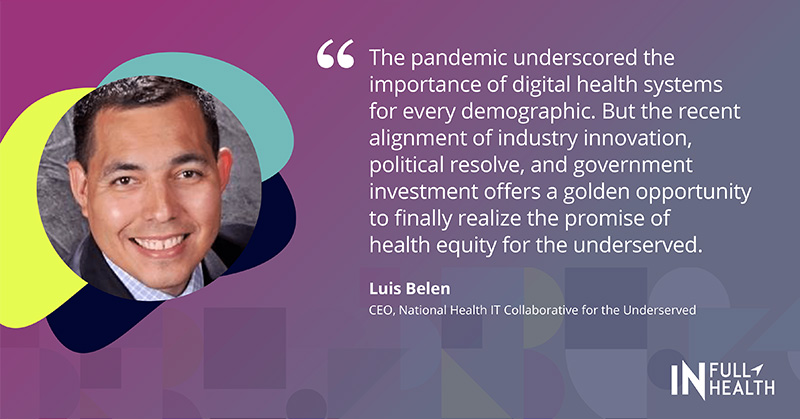Technology is powerful. It impacts how we work, how we live, and even what opportunities we have access to. It can decrease gaps in health equity or exacerbate them.
But imagine a world where all “blind spots” are eliminated in the development of health care solutions. A world where health solutions are created by and for the communities that can benefit from them. A world where equitable development practices are the norm.
Health equity champion Luis Belen is doing just that.
Luis Belen (he/him/his) is the Chief Executive Officer of the National Health IT Collaborative for the Underserved (NHIT). Their vision is, “To achieve health equity and build thriving communities through catalyzing the development and use of health information technology and the stakeholders impacted by its use.”
Luis Belen sat down with the In Full Health Learning & Action Community to tell us a little bit more about this work, his personal interest in health equity and innovation, and how IFH fits into the health innovation ecosystem.
In Full Health (IFH): Why does equity in health innovation matter? And why does it matter to you personally?
Luis Belen, Chief Executive Officer of NHIT: The U.S. Department of Health and Human Services identified disparities in health equity for the underserved nearly 40 years ago — and these gaps still exist.
Meanwhile, health care systems grow ever more enmeshed with information technology and that development holds the potential to either close those gaps or make them wider, depending on how they are designed and implemented. As the trusted voice of the underserved in Health IT matters, our work is more important than ever.
IFH: You have been the Chief Executive Officer of the National Health IT Collaborative for the Underserved for 8 years now. How have you seen the health innovation landscape change in the last 8 years?
Luis Belen: During the [2007 to 2008] global financial crisis, President Obama signed the American Recovery and Reinvestment Act, a massive stimulus bill that included provisions for broadly promoting the adoption of electronic health records. Also important was the passing of The Health Information Technology for Economic and Clinical Health (HITECH) Act of 2009, which is part of the American Recovery and Reinvestment Act (ARRA).
And NHIT was there, ready, partnering with regional extension centers and working on community-based strategies to reach “safety net” providers in communities of color so they and their patients would have equal access to the benefits of this health care revolution.
Today, we find ourselves again in a time of global crisis, brought about by the intersection of the COVID-19 pandemic, the opioid epidemic, and continuing intolerable health disparities. And again a stimulus bill, the Infrastructure Investment and Jobs Act, has allocated resources toward improving health IT access and usage.
SUBSCRIBE
Stay in the loop about new blog posts from equitable health innovation leaders, helpful resources and tools to help you bring the Principles to life, upcoming events, and more by joining our email list.
IFH: What progress have you seen? And on the other side of things, what critical opportunities and obstacles still remain?
Luis Belen: Digital health solutions like telehealth have improved access to health care and offset the impact of several social determinants of health.
[However], for millions in rural areas, health care is often out of reach. Residents are subject to numerous social challenges including physician shortages, long travel times, and inadequate broadband internet services.
Those most at risk in rural areas include migrant farmworkers who face additional barriers due to frequent changes in residency as work demand shifts. The health and well-being of farmworkers have significant national security implications concerning food safety, food supply chain security, and economic stability of the $1.1 trillion agricultural sector.
IFH: NHIT tackles equity from a variety of angles – innovation, policy, research, workforce, and community. Can you talk a little bit about how all of these sectors/foci work together and influence one another?
Luis Belen: We believe that each pillar is important and interconnected, much like social determinants of health. Effective policy is informed by research and community involvement. Innovation is helpful so long as it develops alongside effective, equitable policy. Community should inform the research agenda to be sure we’re asking the right questions and evaluating the right measures. Health IT Innovation requires meaningful community participation in the design and development of those solutions and to ensure underserved communities benefit from those innovations.
IFH: What are you most proud of achieving?
Luis Belen: Our initiatives over the past 2 years have expanded and strengthened our partner network and laid the groundwork for the future of NHIT. We collaborated with Amazon Web Services (AWS) and Tyler Technologies to launch the Data Fusion Center, helping us understand health equity problems and solutions.
We co-founded the Telehealth Equity Coalition, a group now over 150 members strong with the mission to advance equitable telehealth adoption in all communities. We announced a multi-year strategic alliance with Sanitas USA focused on accessible, digitally connected, holistic health care that adapts to family and community needs. And now, as you know, we signed on as a founding collaborator of In Full Health.
Luis Belen
Chief Executive Officer, National Health IT Collaborative for the Underserved
IFH: Speaking of that collaboration — a big part of the In Full Health initiative is the Learning & Action Community to Advance Equitable Health Innovation. What have you learned from your experience at NHIT that the In Full Health community can leverage as they consider effective collaboration models?
Luis Belen: The leaders in the fight for health equity have always been community organizations. They do the work — not for power, profit, or accolades — but to improve the well-being of the marginalized. They stay fixed on their goals and are not swayed by buzzwords and passing trends.
If an organization or group truly cares about marginalized communities, I urge them to be an authentic ally and use their resources and influence to empower and uplift the community organizations that have continued the fight even when others lost focus. The work is more important than organizational vanity. In Full Health can help uplift the voices of community organizations.
 The Principles For Equitable Health Innovation Principle #3
The Principles For Equitable Health Innovation Principle #3
Greater investment is needed in health innovations developed specifically to improve health in and/or eliminate inequities experienced by historically marginalized communities, with resources and support prioritized for innovators designing from within these communities.
IFH: Another key aspect of the In Full Health initiative is The Principles For Equitable Health Innovation. Which of the In Full Health principles is most relevant to the work you’re leading at NHIT and why?
Luis Belen: I may have hinted at this with my answer to the prior question but I would say Principle 3 is key to our approach toward equity. No one knows the challenges and opportunities within underserved communities better than the community members and leaders themselves. We could not do our work effectively without first building trust and partnership within underserved communities and uplifting leaders from those communities.
IFH: What measurable change do you hope to see from the In Full Health initiative?
Luis Belen: I would like to see In Full Health join community-based organizations and launch health equity demonstration projects across the country. I’d like to see trials of novel initiatives that show potential to bridge the equity gap, and I would encourage leaders and innovators to equitably partner with communities and community advocates who have been at the vanguard of health equity for many years.
SUBSCRIBE
Stay in the loop about new blog posts from equitable health innovation leaders, helpful resources and tools to help you bring the Principles to life, upcoming events, and more by joining our email list.


